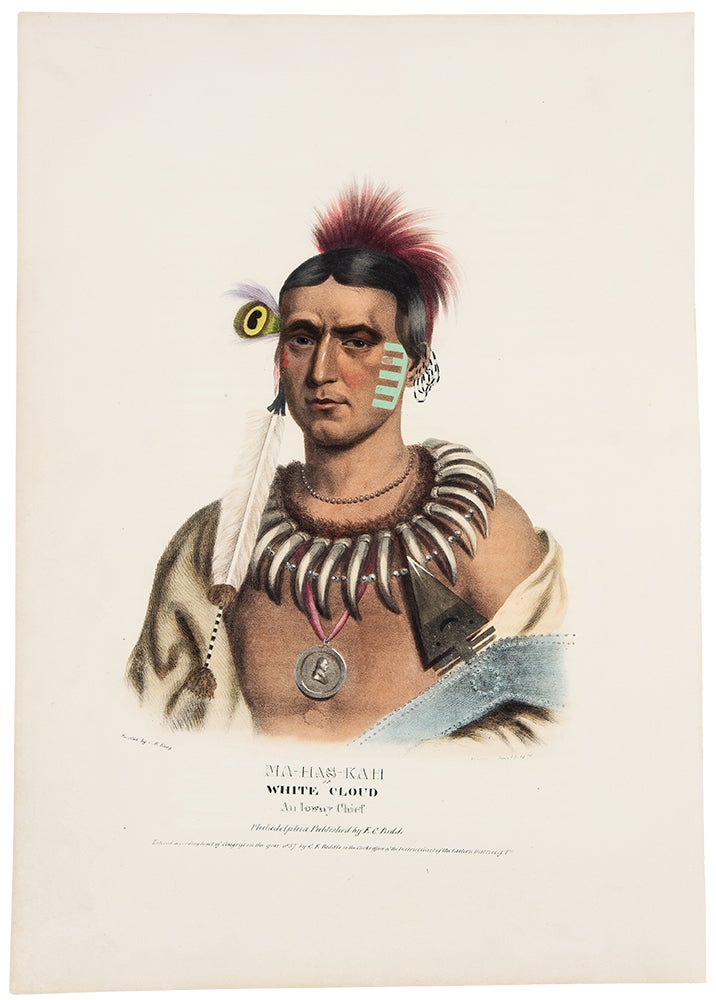MCKENNEY, Thomas L. (1785-1859) and James HALL (1793-1868)
Ma-Has-Ka or White Cloud. An Ioway Chief.
Philadelphia: E. C. Biddle, 1837. Hand-coloured lithograph. Sheet size: 20 x 14 1/2 inches.
A fine image from McKenney and Hall's 'Indian Tribes of North America': `One of the most important [works] ever published on the American Indians' (Field),` a landmark in American culture' (Horan) and an invaluable contemporary record of a vanished way of life.
Ma-Has-Kah or White Cloud, (1784-1834) an Iowa chief, rose to prominence in his tribe through acts of revenge against the Dakota who had killed his father. Later, he settled down to a life of farming with his wives. Mahaska accepted the white man's code of behavior to the extent that when a fellow Iowa was murdered by some Omaha warriors, Mahaska refused to authorize an attack. When some of his braves struck anyway and killed six Omaha, Mahaska assisted in their arrest. A year later one of the warriors arrested escaped from prison and murdered him. Mahaska visited Washington in 1824 with all seven of his wives and met President Monroe. The portrait by Charles Bird King after which this print was made was painted at that time. McKenney and Hall's 'Indian Tribes of North America' has long been renowned for its faithful portraits of Native Americans. The portraits are largely based on paintings by the artist Charles Bird King, who was employed by the War Department to paint the Indian delegates visiting Washington D.C., forming the basis of the War Department's Indian Gallery. Most of King's original paintings were subsequently destroyed in a fire at the Smithsonian, and their appearance in McKenney and Hall's magnificent work is thus our only record of the likenesses of many of the most prominent Indian leaders of the nineteenth century. Numbered among King's sitters were Sequoyah, Red Jacket, Major Ridge, Cornplanter, and Osceola.After six years as Superintendent of Indian Trade, Thomas McKenney had become concerned for the survival of the Western tribes. He had observed unscrupulous individuals taking advantage of the Native Americans for profit, and his vocal warnings about their future prompted his appointment by President Monroe to the Office of Indian Affairs. As first director, McKenney was to improve the administration of Indian programs in various government offices. His first trip was during the summer of 1826 to the Lake Superior area for a treaty with the Chippewa, opening mineral rights on their land. In 1827, he journeyed west again for a treaty with the Chippewa, Menominee , and Winebago in the present state of Michigan. His journeys provided an unparalleled opportunity to become acquainted with Native American tribes. When President Jackson dismissed him from his government post in 1839, McKenney was able to turn more of his attention to his publishing project. Within a few years, he was joined by James Hall, a lawyer who had written extensively about the west. McKenney and Hall saw their work as a way of preserving an accurate visual record of a rapidly disappearing culture. (Gilreath).
Cf. BAL 6934; cf. Bennett p.79; cf. Field 992; cf. Howes M129; cf. Lipperhiede Mc4; cf. Reese, American Color Plate Books 24; Sabin 43410a.
Item #39647
Price: $950.00


